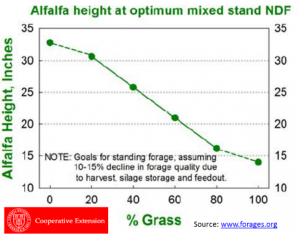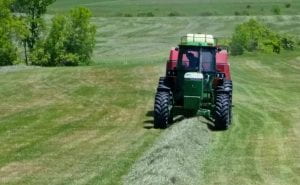This is the team’s third and final week of monitoring alfalfa heights for first cutting quality in 2024. The full report for our six-county region (Broome, Cayuga, Chemung, Cortland, Tioga, and Tompkins Counties) can be found in the following link: Alfalfa Height Reporting Sheet 5.21.24.
This week’s updates:
Our region has seen weather good enough to get hay crop mowed and the movement to the bunks is in full swing. Reports from fields look like a fairly heavy harvest. As you sample your first cutting, feel free to share forage analysis with Janice or myself!
Because of the fact that most all regions are at or near peak dairy quality for pure alfalfa and harvest is occurring, this will be our final week for measurements.
Broome: over 6″ of growth from last week, with some fields already being mowed. Average height of what fields are left are at 27″
Cayuga: over 6″ of growth from last week, with some fields already being mowed. Average height of what fields are left are over 25″
Chemung: almost 6″ of growth over last week, with some fields already being mowed. Average height of what fields are left is over 28″
Cortland: a huge 9″ of growth over last week, with some fields already being mowed. Average height of what fields are left is over 27″
Tioga: almost 7″ of growth over last week, with some fields already being mowed. Average height of what fields are left is over 28″
Tompkins: all fields we measured were already mowed.
A Reminder on our Methods
For prediction of NDF content, the height of alfalfa as an indicator is as follows:
- 100% grass stands – cut when nearby alfalfa is 14 inches tall (achieves 50% NDF)
- 50/50 grass/alfalfa stands – cut when nearby alfalfa is 22 inches tall (achieves 44% NDF)
- 100% alfalfa stands – cut when alfalfa is 28 inches tall (achieve 40% NDF)

Predicted days to cut are based on daily NDF increases for grasses of 1.0% point, 50/50 mixed alfalfa/grass stands of 0.8% points, and alfalfa of 0.5% points and are adjusted for the coming week’s weather. Typically NDF increases about 0.8 to 1.2 per day for grasses, with cooler weather being the lower end of the range and warmer weather being the higher end. For alfalfa, NDF increases about 0.4 to 0.7 per day, also dependent upon warm/cool weather.
Next Report
This concludes our alfalfa reporting for the year. We will still be updating on grass maturity this week and likely next week utilizing scissor cuts to help assess maturity for other classes and species of livestock.
In the meanwhile, if you can’t get out to check your fields, call one of us on the team. We’ll be glad to help out.

